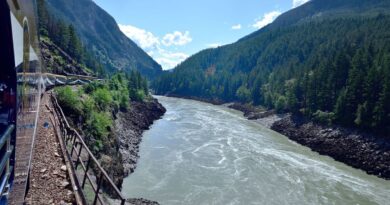The controversial nuclear mega-project that cost £13bn but lies abandoned | World | News
Nuclear waste is one of the deadliest materials on earth, containing radioactive materials that emit ionising radiation which can cause severe damage to living tissues and DNA and increase the risk of cancer, birth defects and other health problems. This is not just a short-term issue, either, as the waste can remain hazardous for thousands of years.
It is, therefore, crucial that this material is disposed of safely. Currently, it is stored above ground near the power plants from which it came. However, scientists have agreed that the safest, permanent disposal solution is storing the hazardous waste underground. Decades ago, the United States set about finding a permanent solution to this growing waste problem – more than 85,000 metric tons – but is not closer to finishing the project as it was in the 1980s.
In 1987, Yucca Mountain – near the border between Nevada and California and about 100 miles from Las Vegas – was identified by US authorities as the best available option. It lies close to the country’s most-used nuclear testing site and is far away from any population centres.
What’s more the mountain is made up of volcanic ash formed millions of years ago, which allows it to absorb any radioactive waste without crumbling or cracking.
The plan was to deposit the waste from all over the US in a tunnel complex about 980 feet (300 metres) under Yucca Mountain.
It sounded like the perfect solution and the project was approved in 2002. However, the project has encountered many difficulties and was highly contested by the public, the indigenous Western Shoshone peoples and many politicians.
One of the main issues was that while the US has over 100 operational and closed nuclear reactor sites across 34 states, none of them were in Nevada. Nevadans, therefore had a major issue with becoming the only nuclear dumping site in the whole country. They also contended that routine exposures during transportation would stigmatise Nevada’s residents and affect tourism in the state.
“The bottom line is this: Nevada does not produce nuclear waste, we have not consented to storing it in our backyard, and we should not have it forced upon us,” said Nevada Democratic Rep, Dina Titus, according to E&E News.
Concerns were also raised about its environmental impact, with opponents believing the site to be unsuitable because it could contaminate a nearby water source used by Native Americans who have lived in the area for centuries.
By the time Barack Obama took office, the project had become highly politicised and during the 112th Congress federal funding for the site was cut. The Government Accountability Office stated that the closure was for political, not technical or safety reasons.
Three years later, a federal court ordered its resumption, but little progress was made. The Biden administration clearly stated that Yucca Mountain was not part of the country’s plans anymore.
The prospect of the project raised its head again last year as Donald Trump began his second term as president, with Republicans saying the dormant repository is the only viable long-term solution to solving the nuclear waste problem. Some Democrats are even starting to reconsider its revival.
“Opposition has inhibited congressional appropriations and driven the executive branch to dismantle what has otherwise been a technically successful program,” said former Energy and Commerce Chair Cathy McMorris Rodgers, prior to the election. “We must continue this committee’s work to update the law and build state support for our permanent repository at Yucca Mountain.”
Yucca Mountain remains, by law, the government’s official plan to deal with the tens of thousands of tons of spent nuclear fuel.




